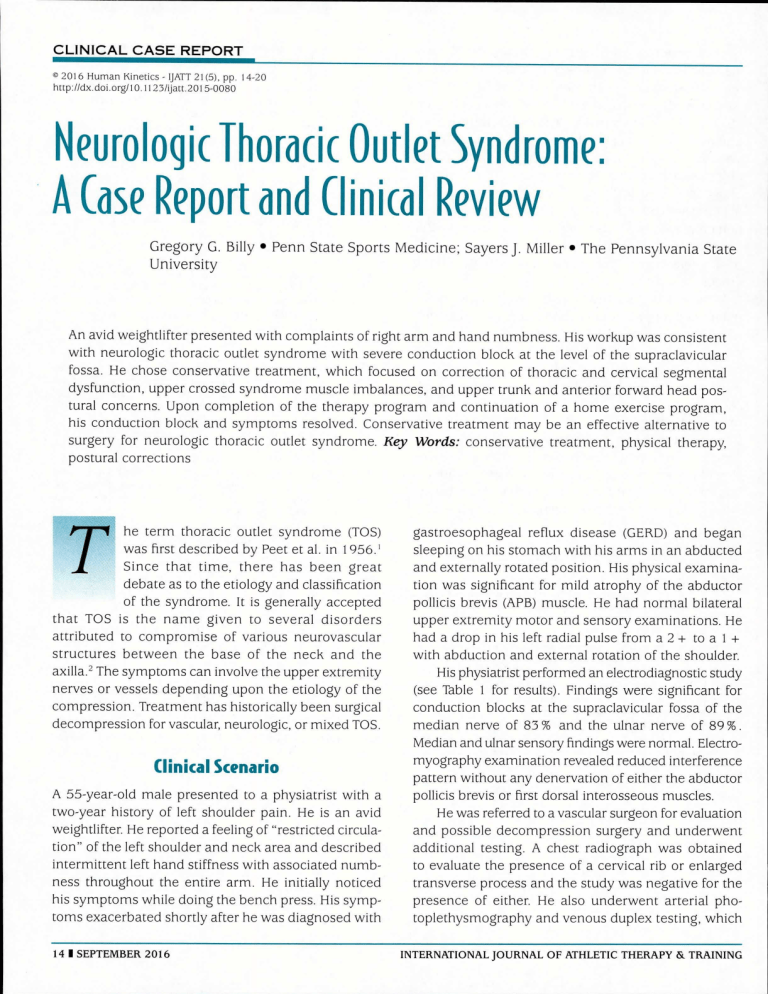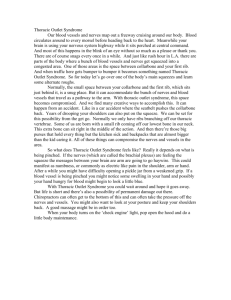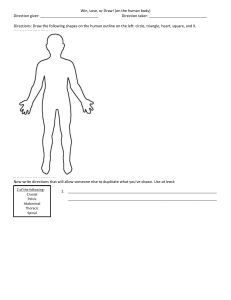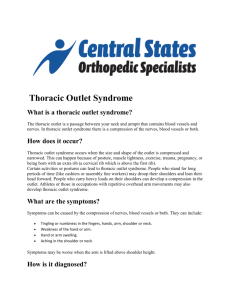
C L IN IC A L C A SE REPO RT ®2016 Human Kinetics - IJATT 21(5), pp. 14-20 http://dx.d0i.0rg/l 0,1123/ijatt.2015-0080 Neurologic Thoracic Outlet Syndrome: A Case Report and Clinical Review Gregory G. Billy • Penn State Sports Medicine; Sayers J. Miller • The Pennsylvania State University An avid weightlifter presented with complaints of right arm and hand numbness. His workup was consistent with neurologic thoracic outlet syndrome with severe conduction block at the level of the supraclavicular fossa. He chose conservative treatment, which focused on correction of thoracic and cervical segmental dysfunction, upper crossed syndrome muscle imbalances, and upper trunk and anterior forward head pos­ tural concerns. Upon completion of the therapy program and continuation of a home exercise program, his conduction block and symptoms resolved. Conservative treatment may be an effective alternative to surgery for neurologic thoracic outlet syndrome. Key Words: conservative treatment, physical therapy, postural corrections he term thoracic outlet syndrome (TOS) was first described by Peet et al. in 1956.' Since that time, there has been great debate as to the etiology and classification of the syndrome. It is generally accepted that TOS is the name given to several disorders attributed to compromise of various neurovascular structures between the base of the neck and the axilla.2The symptoms can involve the upper extremity nerves or vessels depending upon the etiology of the compression. Treatment has historically been surgical decompression for vascular, neurologic, or mixed TOS. Clinical Scenario A 55-year-old male presented to a physiatrist with a two-year history of left shoulder pain. He is an avid weightlifter. He reported a feeling of “restricted circula­ tion” of the left shoulder and neck area and described intermittent left hand stiffness with associated numb­ ness throughout the entire arm. He initially noticed his symptoms while doing the bench press. His symp­ toms exacerbated shortly after he was diagnosed with 14 I SEPTEMBER 2016 gastroesophageal reflux disease (GERD) and began sleeping on his stomach with his arms in an abducted and externally rotated position. His physical examina­ tion was significant for mild atrophy of the abductor pollicis brevis (APB) muscle. He had normal bilateral upper extremity motor and sensory examinations. He had a drop in his left radial pulse from a 2 + to a 1 + with abduction and external rotation of the shoulder. His physiatrist performed an electrodiagnostic study (see Table 1 for results). Findings were significant for conduction blocks at the supraclavicular fossa of the median nerve of 83 % and the ulnar nerve of 89 %. Median and ulnar sensory findings were normal. Electro­ myography examination revealed reduced interference pattern without any denervation of either the abductor pollicis brevis or first dorsal interosseous muscles. He was referred to a vascular surgeon for evaluation and possible decompression surgery and underwent additional testing. A chest radiograph was obtained to evaluate the presence of a cervical rib or enlarged transverse process and the study was negative for the presence of either. He also underwent arterial pho­ toplethysmography and venous duplex testing, which INTERNATIONAL JOURNAL OF ATHLETIC THERAPY & TRAINING Ta b l e 1 m otor C o n d u c t io n S t u d ie s Seq. Amplitude Amplitude Distance Velocity Temperature (cm) (mV) (% ) (°() (m/s) Rec. Site Lat. (ms) Wrist APB 3.8 5 11.4 100 8 Elbow APB 8.0 5 11.6 102 22 Nerve/Sites L M e d ia n —APB July 2 0 1 4 30 .2 5 2 .4 30 .2 Axilla APB 12.10 10.6 91.7 22 54.3 30 .2 Supraclavicular fossa APB 17.80 0.9 8.74 19 33.3 30 .2 Wrist APB 3 .5 0 11.7 100 8 Elbow APB 7.40 11.7 100 22 56 .4 31.7 Axilla APB 11.10 11.5 98.3 22 59 .5 31.7 71.7 31.7 L M e d ia n — APB F ebruary 2015 31.6 APB 13.75 11.6 100 19 Wrist ADM 4.0 5 9.6 100 8 B. Elbow ADM 8.3 5 7.3 7 6.5 23 52.3 30 .2 30 .3 Supraclavicular fossa L U ln ar— ADM July 2 0 1 4 30.3 A. Elbow ADM 10.85 6.5 8 9.4 8 4 4 .4 Axilla ADM 8 .1 5 6.2 94.3 16 59.3 30.3 Supraclavicular fossa ADM 15.65 0.4 5.89 19 25.3 30.3 Wrist ADM 3.6 5 11.8 100 8 B. Elbow ADM 8.1 5 10.4 8 7 .6 23 51.1 31.2 A. Elbow ADM 10.45 9.8 9 4 .5 8 47.1 31.8 Axilla ADM 12.80 10.3 105 16 68.1 31 L U ln ar—ADM F eb ru ary 2 0 1 5 31.4 107 19 Supraclavicular fossa ADM 15.30 11.0 7 6.0 31 Abbreviations: Rec. = recording; Lat. = latency; Seq. = sequential;; L = left; APB = abductor pollicis brevis; ADM = adductor digiti minimi; B. = below; A. = above. Note. This table shows the results of the nerve conduction studies and conduction blocks of the median and ulnar nerves. It also shows the fol­ low-up study results with noted resolution of the blocks. did not show any obstruction of flow in either the neu­ tral or abducted positions of the shoulders in either the arterial or venous vessels. He deferred decompression surgery and wanted to proceed conservatively with physical therapy. Physical therapy was initiated, with the patient attending a total of nine sessions over a 12-week period. Each treatment session consisted of 30 min of manual therapy followed by approximately 30 min of exercise. The program involved forward head posture correction education; mid to upper thoracic, cervicothoracic junction, upper rib, and lower to mid cervical mobilization/manipulation; cervical retrac­ tion range of motion exercises; myofascial release; stretching of scalene and pectoralis minor muscles; and strengthening of the lower trapezius and serraINTERNATIONAL JOURNAL OF ATHLETIC THERAPY &. TRAINING tus anterior. Mobilization/manipulation procedures used during the course of treatment are illustrated in Figure 1.The treatment plan addressed findings of thoracic and cervical segmental dysfunction, scalene and pectoralis minor hypertonus/tightness, adverse upper limb neural tension, upper crossed syndrome muscle imbalances, anteriorly tilted scapulae, and forward head posture. His specific treatment plan is described in Table 2. The focus of the treatment plan was to address the spinal segmental causes of muscle hypertonus and neural irritation, improve posture and scapular position, and establish a home exercise pro­ gram for self-care. Exercises were added or progressed based in part on the patient’s progress, symptoms, and motivation. Representative exercises are illustrated in Figure 2 and the home exercise program is outlined SEPTEMBER 2016 I 15 Figure 1 Manual therapy techniques. The accompanying figures show the specific manual therapy techniques used. (A) Cervicothoracic junction side bending manipulation. (B) Cervical rotation mobilization/manipulation. (C) Midthoracic rotational PA mobilization/manipulation. (D) Mid to upper thoracic AP manipulation. Ta b l e 2 Session l P h y s ic a l T h e r a p y T r e a t m e n t P l a n Treatments Initial ev a lu a tio n . P o stu re a n d b o d y m e c h a n ic in stru c tio n . Mid to u p p e r th o rac ic, c e rv ic o th o ra c ic ju n c tio n , u p p e r rib, a n d low er to m id cervical m o b iliz a tio n /m a n ip u la tio n . In stru c te d in cerv ical re tra c tio n activ e ra n g e of m o tio n ex ercises. 2 C o n tin u ed w ith above. A dded low er tra p e z iu s a n d sc a p u la r p ro tra c tio n (all 4s p o sitio n w ith o p p o site a rm a n d leg e x te n d e d ) exercise. A dded p re ssu re re le a se a n d stre tc h in g to sc a le n e s a n d p ec to ralis m inor. In stru c te d in a n te rio r c h e st stretch in g . 3 S a m e as se ssio n 2. 4 C o n tin u e d w ith ab o v e w ith th e a d d itio n of w all a n g e ls (ch allen g es th o ra c ic e x te n sio n , a n te rio r c h e s t flexibility, sh o u ld e r e x te rn a l ro tatio n m ob ility a n d p ro v id ed low er tra p e z iu s stre n g th e n in g ) a n d s c a p u la r sta b ility m o to r co n tro l ex e rc ise (p a tie n t s ta n d s facing w all, p re ssin g ball a g a in st wall w ith sc a p u la p ro tra c te d , th e n p e rfo rm in g CW a n d CCW m o v e m e n ts w hile m a in ta in in g sc a p u la r po sitio n ). 5 S a m e m o b iliza tio n a n d s tre tc h in g /re le a se p ro c e d u re s a n d ex e rcise s. A dded sc a p u la r p ro tra c tio n w ith h a n d on BOSU in all 4s p o sitio n w ith s a m e sid e leg e x te n d e d a n d 35-lb d u m b b e ll in o p p o site h a n d . Also a d d e d w all p u s h u p s w ith a plus a n d s c a p tio n ex e rc ise w ith a 5-lb w eig h t. 6 S a m e as se ssio n 5. 7 A dded sta n d in g sh o u ld e r e x te rn a l ro ta tio n w ith d u m b b e ll in sid e b e n t p o sitio n a n d sta n d in g D2 PNF p a tte rn w ith m ini lunge. T he p a tie n t a d d e d T-bar row s at h o m e . 8 C o n tin u e d w ith m a n u a l th e ra p y a n d ex ercises. A ddition of s h o u ld e r e x te rn a l ro ta tio n w ith pulley, lo w er tra p e ­ zius “Y” e x e rc ise w ith pulley, a n d D2 PNF w ith lunge. 9 C o n tin u e d w ith m a n u a l therap y . A dded sc a p u la r stab ilizatio n w ith B ody Blade, d y n a m ic p ra y e r stre tc h (ch ild ’s po se) w ith s c a p u la r p ro tra c tio n , a n d sta n d in g sh o u ld e r slid es (sh o u ld er flexion w ith sc a p u la r p ro tra c tio n e x e r­ cise to facilitate s c a p u la r control). Abbreviations: CW = chest wall; CCW = contralateral chest wall; PNF = proprioceptive neuromuscular facilitation. Note. This table outlines the emphasis of each physical therapy session. 16 I SEPTEMBER 2016 INTERNATIONAL JOURNAL OF ATHLETIC THERAPY 5 l TRAINING Figure Z Demonstration of the home exercise program. The series of figures highlight some of the exercises of the home exercise program. (A) Anterior chest elevation with cervical retraction and upper cervical flexion. (B) Cervical retraction. (C) Scapular protraction. (D) Wall angels. (E) Lower trapezius strength exercise. INTERNATIONAL JOURNAL OF ATHLETIC THERAPY St TRAINING SEPTEMBER 2016 I 17 Ta b l e 3 Emphasis Postural advice Active range of motion Strengthening Stretching N o te . H o m e E x e r c is e P r o g r a m Exercise Anterior chest elevation with cervical retraction and upper cervical flexion Cervical retraction Lower trapezius retraction Scapular protraction in all 4s Shoulder flexion wall slides Anterior chest stretching Wall angels Frequency As much as possible throughout day 10 reps, 5-6 times daily 3 sets of 10 daily 3 sets of 10 daily 3 sets of 10 daily 3-5 30-s stretches, 2-3 x /day 3 sets of 10 daily This table indicates the emphasis, exercise, and frequency of the patient’s home exercise program. in Table 3. The patient remained adherent to a daily exercise program and has not had any recurrence of symptoms. He returned for follow-up evaluation and noted complete resolution of his symptoms and a follow up electrodiagnostic study was performed (see Table 1 for results). Findings were significant for complete resolution of his prior median and ulnar conduction blocks at the supraclavicular fossa. Electromyography examination also showed resolution of the reduced interference pattern of the opponens pollicis and first dorsal interosseous muscles. Discussion TOS may vary in its clinical presentation due to either vascular and/or neurologic compression. A classifi­ cation proposed by Wilbourn defined vascular, neu­ rologic, and neurovascular types, and the neurologic classification was further divided into true and non­ specific subtypes based upon specific electrodiagnostic findings.3 Nonspecific TOS represents the majority of TOS cases, upwards of 85 %.4’5 Vascular TOS includes approximately 5-10% of all TOS cases.6 Vascular TOS can be further subdivided into arterial TOS or venous TOS. Vascular TOS typically involves compression of the subclavian and/or axillary vessels. Nonspecific cases of TOS usually dem onstrate no bony or soft tissue abnormality. The potential site of entrapment is beneath the tendon of the pectoralis minor muscle where the plexus is vulnerable to stretching by shoulder abduction.7' 9 The patient’s symptoms were first noted with the bench press, 18 I SEPTEMBER 2016 which places the shoulders in an abducted position, and were later exacerbated with sleeping prone with abducted shoulders. Intermittent compression of the neurovascular complex is felt to be due to repetitive postural, occupational, or sporting forces that create temporary compression at varying sites.10 Our patient responded to a specific protocol to improve tightness and compression at the scalene and pectoralis areas. True neurologic TOS is very rare, with an esti­ mated incidence of one case per million or two cases detected every year in an electrodiagnostic clinic out of approximately every 2,000 patients.11 True neurologic TOS occurs far more commonly in females who often suffer from severe atrophy of the thenar muscles.12 Nerve conduction findings classically show an absent or reduced medial antebrachial cutaneous sensory nerve action potential (SNAP), reduced ulnar sensory SNAP, and reduced median motor compound muscle action potential (CMAP), while electromyography findings revealed absent or reduced abductor pollicis motor unit action potentials (MUAP).12' 15 Radiographic abnormalities including cervical ribs and elongated C7 transverse processes are typically present, and patients benefit from surgical decompression of an associated fibrous band. This clinical case is unique given the dramatic electrodiagnostic findings at the time of presentation. Other studies in the literature describe the benefits of conservative treatment for TOS, although their diagno­ ses are based on clinical symptoms of the patient and not objective measures.16-19 The electrodiagnostic study shows both conduction block and median/ulnar nerve conduction velocity drops of 25~33m/s across the site of compression, which then normalized to 71 -76 m/s INTERNATIONAL JOURNAL OF ATHLETIC THERAPY & TRAINING following treatment. The findings normalized over a 10-12 week period, which is surprising given the sig­ nificance of the compression. Electrodiagnostic studies have shown such prolonged interpeak and absolute latencies with proximal stimulation to be significant.22 The improvements were clinically validated with the resolution of the electrodiagnostic changes. Given the clinical and electrodiagnostic findings, a surgical approach was considered.20'21 The patient did not exhibit signs of vascular compromise, but it is important to remember when working patients up for TOS, the neurogenic and vascular compromise may frequently coexist.23 The patient underwent the vascular studies to rule out a vascular component. In addition, surgery may also be of benefit in patients with electrodiagnostic findings of denervation, as it has been shown that early decompression decreases the occurrence of muscle wasting and denervation of nerves compared with late surgery.24 Our patient showed neither vascular compromise nor denervation. The clinical response of the patient was noted over a 12-week time period and is in agreement with an advocated conservative approach of therapies for up to three months.25 The dramatic resolution of both the conduction block and clinical findings with the afore­ mentioned therapy principles suggest a conservative option may be an appropriate treatment for patients with nonspecific neurologic TOS, and the clinical utility of serial electrodiagnostic studies. This case highlights effective interprofessional and interdisciplinary patient care between the patient’s physiatrist, vascular con­ sultant, and physical therapist. Given the complexity of TOS, coordinated effort fosters the likelihood of a successful outcome. Lastly, this case illustrates a conservative approach to significant neurologic thoracic outlet syndrome with conduction block caused by postural problems, tight and imbalanced muscles, and related cervical and thoracic joint dysfunction in a weightlifter. He was able to avoid surgery with a physical therapy program that addressed these concerns via postural education, manual therapy, and exercise. Conservative treatment may be an effective alternative to surgery for neuro­ logic TOS. C lin ic a l B o tto m Lino The literature can be conflicting in recommending sur­ gery or conservative care. This case presented is unique INTERNATIONAL JOURNAL OF ATHLETIC THERAPY &. TRAINING given the improvements in clinical findings were confirmed by resolution of objective electrodiagnostic findings in TOS. We strongly support the conservative approach outlined in the report for nonspecific TOS. I References 1. Peet RM, Henriksen MD, Anderson TP, Martin GM. Thoracic outlet syndrome: evaluation of a therapeutic exercise program. Proc Staff Meet May Clin. 1956;31:281-287. PubMed 2. Gilliatt RW. Thoracic outlet syndromes. In: Dyck PJ, Thomas PK, Lam­ bert EH, Bunge R, eds. Peripheral neuropathy. 2nd ed. Philadelphia: WB Saunders; 1984:1409. 3. Wilbourn AJ. Thoracic outlet syndrome, in: Syllabus, Course D: Controversies in entrapment neuropathies. Rochester, MN: American Association of Electromyography and Electrodiagnosis; 1984:28. 4. Sanders RJ, Annest SJ. Technique of supraclavicular decompression for neurogenic thoracic outlet syndrome.,/ Vase Surg. 2015;61 (3):821 -825 doi: 10.1016/j.jvs.2014.11.047. PubMed 5. Povlsen B, Hansson T, Povlsen SD. Treatment for thoracic outlet syndrome. Cochrane Database Syst Rev. 2014;11:CD007218. PubMed 6. Vanti C, Natalini L, Romeo A, Tosarelli D, Pillastrini P. Conservative treatment of thoracic outlet syndrome. A review of the literature. Eura Medicophys. 2007;43(l):55-70 Epub 2006 Sep 24. PubMed 7. Ranney D. Thoracic outlet: an anatomical redefinition that makes clinical sense. Clin A m t. 1996;9(1):50—52. PubMed doi: 10.1002/ (SICI) 1098-2353(1996)9:1 < 50::A1D-CA10 > 3.0.CO;2-9 8. Rayan GM. Thoracic outlet syndrom e. J Shoulder Elbow Surg. 1998;7(4):440-451. PubMed doi: 10.1016/S1058-2746(98)90042-8 9. Demondion X, Bacqueville E, Paul C, Duquesony B, Hachulla E, Cotten A. Thoracic outlet: assessment with MR imaging in asymptomatic and symptomatic populations. Radiology. 2003;227(2):461 -468 Epub 2003 Mar 13. PubMed doi: 10.1148/radiol.2272012111 10. Watson LA, Pizzari T, Balster S. Thoracic outlet syndrome part 1: clinical manifestations, differentiation and treatment pathways. Man Ther. 2009;14(6):586-595 doi:10.101 6/j.math.2009.08.007 Epub 2009 Sep9. PubMed 11. Gilliatt RW. Thoracic outlet syndromes. In: Dyck PJ, Thomas PK, Lam­ bert EH, Bunge R, eds. Peripheral Neuropathy. Philadelphia: Saunders; 1984:1409-1424. 12. Le Forestier N, Moulonguet A, Maisonobe T, LegerJM, Bouche P. True neurogenic thoracic outlet syndrome: electrophysiological diagnosis in six cases. Muscle Nerve. 1998;21 (9): 1129—1134. PubMed doi: 10.1002/ (SICI) 1097-4598(199809)21:9 < 1129::A1D-MUS3 > 3.0.CO;2-9 13. Kothari MJ, Macintosh K, Heistand M, Logigian EL. Medial antebrachial cutaneous sensory studies in the evaluation of neurogenic thoracic outlet syndrome. Muscle Nerve. 1998:21 (5):647-649. PubMed doi: 10.1002/ (SICI) 1097-4598(199805)21:5 < 647::A1D-MUS13 > 3.0.CO;2-S 14. Machanic BI, Sanders RJ. Medial antebrachial cutaneous nerve mea­ surements to diagnosis neurogenic thoracic outlet syndrome. Ann Vase Surg. 2008;22(2):248-254 doi:10.1016/j.avsg.2007.09.009. PubMed 15. Tsao BE, Ferrante MA, Wilbourn AJ, Shields RW. Electrodiagnostic features of true neurogenic thoracic outlet syndrome. Muscle Nerve. 2014;49(5):724—727 doi:10.1002/mus.24066. PubMed 16. Walsh MT. Therapist m anagem ent of thoracic outlet syndrome. J Hand Ther. 1994;7(2): 131-1 44. PubMed doi: 10.101 6/S08941130(12)80083-4 17. Bilancini S, Lucci M, Tucci S, Di Rita L. Postural physiotherapy: a possible conservative treatm ent of the thoracic outlet syndrome. Angiologia. 1992;44(2):67-72. PubMed 18. Novak CB, Collins ED, Mackinnon SE. Outcome following conser­ vative management of thoracic outlet syndrome. J Hand Surg Am. 1995;20(4):542-548. PubMed doi:10.1016/S0363-5023(05)80264-3 SEPTEMBER 2016 I 19 19. Lindgren KA. Conservative treatm ent of thoracic outlet syndrom e: a 2-year follow-up. Arch Phys Med Rehabil. 1997;78(4):373-378. PubMed doi: 10.1016/S0003-9993(97)90228-8 20. Landry GJ, Moneta GL, Taylor LM, Jr, Edwards JM, Porter JM. Long-term functional outcom e of neurogenic thoracic outlet syndrom e in surgi­ cally and conservatively treated p a tie n ts ./VaseSurg. 2001 ;33(2):312 319. PubMed doi: 10.1067/m va.2001.112950 21. Chang DC, Rotellini-Coltvet LA, Mukherjee D, De Leon R, FreischlagJA. Surgical intervention for thoracic outlet syndrom e improves p atient’s quality of life./ Vase Surg. 2009;49(3):630-635; discussion 635-637. 22. Papathanasiou E, Zam ba E, Papacostas S. Normative values for high voltage electrical stimulation across the brachial plexus. Electromyogr Clin Neurophysiol. 2002;42(3): 151-157. PubMed 23. Likes K, Rochlin DH, Call D, FreischlagJA. Coexistence of arterial com­ pression in patients with neurogenic thoracic outlet syndrome. JAMA Surg. 2014; 149(12): 1240-1243 doi: 10.1001 /jamasurg.2014.280. PubMed 20 I SEPTEMBER 2016 24. Al-Hashel JY, El Shorbgy AA, Ahmed SF, Elshereef RR. Early versus late surgical treatm en t for neurogenic thoracic outlet syndrom e. 1SRN Neurol. 2013 Sep 10:2013:673020. doi:10.1155/2013/673020. eCollection 2013. 25. Lee J, Laker S, Fredericson M. Thoracic outlet syndrom e. PM R. 2010;2(l):64-70. PubMed doi:10.1016/j.pmrj.2009.12.001 Gregory G. Billy is w ith th e D e p a rtm e n t of O rth o p aed ics a n d R eha­ bilitation, Penn State Sports M edicine, State College, PA. Sayers J. M iller is w ith th e D e p a rtm e n t of Kinesiology, The Pennsyl­ vania State University, U niversity Park, PA. Trent Nessler, PT, DPT, MPT, C ham pion Sports M edicine/Physiotherapy A ssociates, is th e re p o rt e ditor for this article. INTERNATIONAL JOURNAL OF ATHLETIC THERAPY 5t TRAINING Copyright of International Journal of Athletic Therapy & Training is the property of Human Kinetics Publishers, Inc. and its content may not be copied or emailed to multiple sites or posted to a listserv without the copyright holder's express written permission. However, users may print, download, or email articles for individual use.




